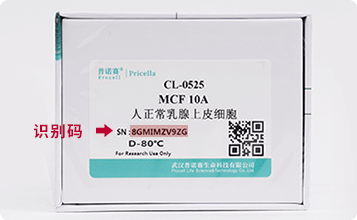货号: CL-0202
Price: ¥1600 ¥1600
生长培养基: McCoy's 5A[PM150710]+15% FBS[164210]+1% P/S[PB180120]
产品信息
| 产品名称 | Saos-2(人成骨肉瘤细胞) |
| 别称 | SAOS-2; Saos-2; SAOS 2; Saos 2; Saos2; SaOs2; SAOS2; Sarcoma OSteogenic-2; SaOS; SAOS |
| 生长特性 | 贴壁细胞 |
| 细胞形态 | 上皮细胞样 |
| 冻存条件 |
冻存液:55% 基础培养基+40% FBS+5% DMSO 温度:液氮 |
| 培养方案A(默认) |
生长培养基:McCoy's 5A[PM150710]+15% FBS[164210]+1% P/S[PB180120] 培养条件: 气相:空气,95%;CO₂,5%, 温度:37℃ |
| 培养方案B(可选) |
生长培养基: 培养条件: 气相:, 温度:37℃ |
| 推荐传代比例 | 1:2-1:3 |
| 推荐换液频率 | 2-3次/周 |
参考资料(来源文献)
| 背景描述 | Saos-2细胞是由J·Fogh和G·Trempe分离和鉴定的众多人肿瘤细胞系中的一种。该病人曾经多种药物治疗,包括RTG、methotrexate、adriamycin vincristine、cytoxan和aramycin-C。Saos-2细胞在免疫抑制小鼠中不致瘤,但在半固体培养基中形成集落。 |
| 年龄(性别) | 11Y Female |
| 组织来源 | 骨;骨肉瘤 |
| 细胞类型 | 肿瘤细胞 |
| 肿瘤类型 | 肉瘤细胞 |
| 生物安全等级 | BSL-1 |
| 致瘤性 | No, The cells were not tumorigenic in immunosuppressed mice, but did form colonies in semisolid medium. |
| 受体表达情况 | epidermal growth factor (EGF); transforming growth factor beta (Type 1 and Type 2) |
STR位点信息
STR鉴定图
-
Circular RNA hsa_circ_001350 contributes to osteosarcoma progression by regulating microRNA-578/CCR4-NOT transcription complex and subunit 7/Wnt signaling(2023)
作者:Rujin Xu, Xingyuan Ci, Fang He, Yueqin Chen
期刊:American Journal of Cancer Research
DOI:PMID:37424831
影响因子:5.3
引用产品: hFOB 1.19 细胞, U-2 OS [U2OS] 细胞, HOS 细胞, Saos-2 细胞, MG-63 细胞
-
HTRA3 transcriptionally inhibited by FOXP1 suppresses tumorigenesis of osteosarcoma via the PTEN/PI3K/AKT pathway(2023)
作者:Ziyuan Tong, Yuan Shen, Quan Yuan, Honghao Yu
期刊:BIOCHIMICA ET BIOPHYSICA ACTA-MOLECULAR CELL RESEARCH
DOI:10.1016/j.bbamcr.2023.119553
影响因子:5.1
引用产品: HOS 细胞, Saos-2 细胞, SW 1353 细胞, McCoy's 5A 培养基
-
RING finger gene 180 inhibits osteosarcoma progression through regulating chromobox homolog 4 ubiquitination(2023)
作者:Qirui Zhao, Ning Liu, Tongtong Xu, Keguan Song
期刊:CELL CYCLE
DOI:10.1080/15384101.2023.2205201
影响因子:4.3
引用产品: 293T [HEK-293T] 细胞, hFOB 1.19 细胞, MNNG/HOS Cl #5 [R-1059-D] 细胞, Saos-2 细胞, MG-63 细胞, U-2 OS [U2OS] 细胞
-
hsa_circ_0020378 regulating miR-339-3p/COL1A1 promotes osteosarcoma progression(2023)
作者:Liang Liu, Wenze Huang
期刊:CANCER BIOLOGY & THERAPY
DOI:10.1080/15384047.2023.2274120
影响因子:3.6
引用产品: hFOB 1.19 细胞, HOS 细胞, Saos-2 细胞, SW 1353 细胞, Leibovitz's L-15 培养基, McCoy's 5A完全培养基 (含10%FBS), MEM 培养基, DMEM/F12 培养基, 青霉素-链霉素溶液 (双抗),100×, 特级胎牛血清
-
Exosomal miR-331-3p derived from chemoresistant osteosarcoma cells induces chemoresistance through autophagy(2023)
作者:Meng Chenyang, Yang Yun, Feng Wei, Ma Penglei, Bai Rui
期刊:Journal of Orthopaedic Surgery and Research
DOI:10.1186/s13018-023-04338-8
影响因子:2.6
引用产品: MG-63 细胞, HOS 细胞, U-2 OS [U2OS] 细胞, Saos-2 细胞
-
DEPDC1 and KIF4A synergistically inhibit the malignant biological behavior of osteosarcoma cells through Hippo signaling pathway(2023)
作者:Yang Mingming, Zhang Hang, Gao Shichang, Huang Wei
期刊:Journal of Orthopaedic Surgery and Research
DOI:10.1186/s13018-023-03572-4
影响因子:2.6
引用产品: hFOB 1.19 细胞, U-2 OS [U2OS] 细胞, Saos-2 细胞, MG-63 细胞
-
Developing a Versatile Multiscale Therapeutic Platform for Osteosarcoma Synergistic Photothermo-Chemotherapy with Effective Osteogenicity and Antibacterial Capability(2022)
作者:Yunlong Ma, Lan Jiang, Jie Hu, Enjun Zhu, Nan Zhang
期刊:ACS Applied Materials & Interfaces
影响因子:10.4
引用产品: Saos-2 细胞, MDA-MB-231 细胞
-
Comprehensive analysis of a glycolysis and cholesterol synthesis-related genes signature for predicting prognosis and immune landscape in osteosarcoma(2022)
作者:Xu Fangxing, Yan Jinglong, Peng Zhibin, Liu Jingsong, Li Zecheng
期刊:Frontiers in Immunology
DOI:10.3389/fimmu.2022.1096009
影响因子:8.8
引用产品: MG-63 细胞, U-2 OS [U2OS] 细胞, Saos-2 细胞, HOS 细胞, hFOB 1.19 细胞
-
CKB affects human osteosarcoma progression by regulating the p53 pathway(2022)
作者:Fengxin Zhou, Xinli Dou, Chenguang Li
期刊:American Journal of Cancer Research
DOI:PMID:36381321
影响因子:5.9
引用产品: U-2 OS [U2OS] 细胞, hFOB 1.19 细胞, Saos-2 细胞, HOS 细胞, MG-63 细胞
-
Integrated analysis of anti-tumor roles of BAP1 in osteosarcoma(2022)
作者:Hu Dong, Zheng Yongbin, Ou Xuehai, Zhang Lijun, Du Xiaolong, Shi Shaoyan
期刊:Frontiers in Oncology
影响因子:5.7
-
Q1:为什么我看的文献里的细胞培养条件和你们官网的培养条件不一样呢?
部分细胞是会出现多种培养条件的,我们公司优先选择引种来源的培养条件以及建系者所用培养条件,出现差异的原因是不同实验室在保藏过程中更改了细胞的培养条件,为了避免细胞突然更换培养条件后不适应,建议您优先使用厂家推荐的培养条件培养。

识别码示意图





